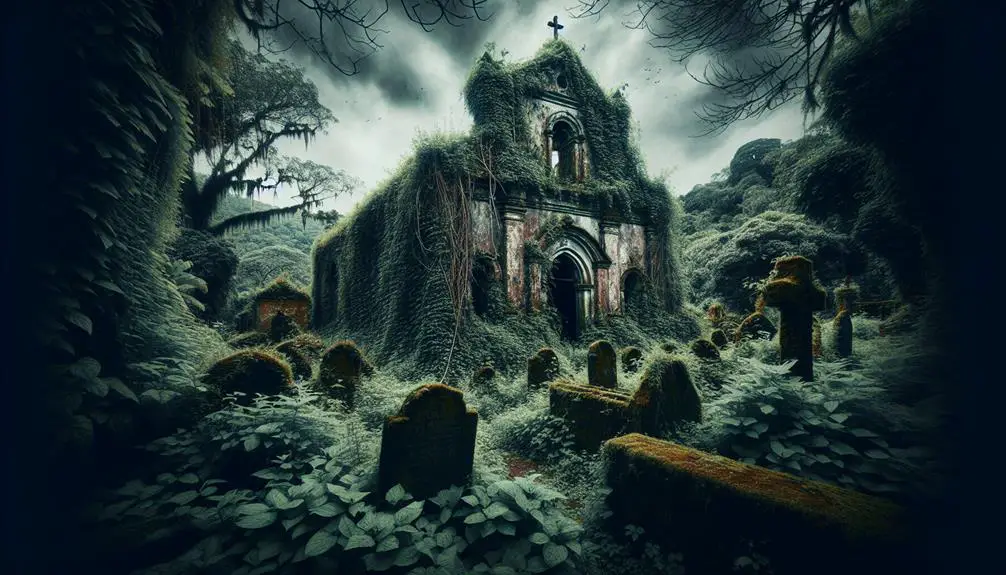Plunge into a meticulously curated database showcasing colonial ghost town remnants. Uncover the historical tapestry of early settlements and abandoned communities. Understand the significance of these ghost towns for insights into societal structures and cultural preservation efforts. Explore colonial era abandonments through archaeological discoveries, urban exploration, and geospatial analysis. Discover notable sites like Roanoke Colony and Bodie, offering tangible connections to the past. Learn about preservation efforts involving community engagement and meticulous research. Advance your knowledge of colonial ghost towns by exploring artifacts, structures, and advanced technologies. Unearth the enigmatic stories behind these remnants.
Key Points
- Compilation includes archaeological findings, structures, and artifacts.
- Database showcases distribution, trends, and anomalies of colonial ghost town remnants.
- Incorporates urban exploration data for firsthand accounts.
- Utilizes advanced geospatial technologies for detailed mapping.
- Offers comprehensive historical documentation for preservation and research.
Significance of Colonial Ghost Towns
Understanding the historical importance of colonial ghost towns provides valuable insights into the early settlements and societal structures of that time period. These abandoned settlements hold a significant place in cultural preservation efforts as they offer a window into the past, showcasing the daily lives, architecture, and community dynamics of early colonial settlers. By studying these ghost towns, historians can unravel the historical significance of various cultural practices, economic systems, and social hierarchies that were prevalent during the colonial era.
Colonial ghost towns serve as tangible remnants of a bygone era, offering a tangible connection to our collective history. They provide a unique opportunity to explore the impact of colonization on indigenous populations, the interactions between different cultural groups, and the consequences of rapid urbanization. Through careful examination and documentation of these sites, we can ensure that their historical significance is preserved for future generations to learn from and appreciate. By recognizing the importance of these abandoned settlements, we can gain a deeper understanding of the complex tapestry of our shared past.
Mapping Colonial Era Abandonments
Exploring the geographical distribution and historical contexts of colonial era abandonments provides a foundation for mapping the impact of early settlements on the landscape and understanding patterns of societal development.
When considering the mapping of colonial era abandonments, there are several important aspects to keep in mind:
- Archaeological Discoveries: Uncovering and documenting archaeological remnants in abandoned colonial sites are essential for piecing together the history of these settlements. Each artifact found contributes to painting a more detailed picture of life during the colonial era.
- Urban Exploration: Engaging in urban exploration activities allows for firsthand experiences within these abandoned colonial towns. Through exploring the remnants, one can better grasp the layout and structures that once defined these settlements, providing valuable insights into their past inhabitants' way of life.
- Geospatial Analysis: Utilizing advanced geospatial technologies enables researchers to create detailed maps that showcase the distribution of colonial era abandonments. These maps help in identifying trends, clusters, and anomalies, shedding light on the broader historical narrative of colonial settlements.
Preserving Colonial Ghost Town Heritage
To effectively safeguard the historical significance of colonial ghost towns, meticulous preservation efforts must be implemented. Heritage preservation is an essential aspect of maintaining the rich tapestry of our past. Community engagement plays a critical role in ensuring that these remnants aren't lost to time. By involving local residents, historians, and preservation experts, a shared sense of responsibility is fostered towards protecting these valuable sites.
Preserving colonial ghost town heritage requires a multi-faceted approach. It involves conducting thorough research to understand the historical context of these towns, documenting existing structures, and implementing conservation measures to prevent further deterioration. Community engagement can be fostered through educational programs, volunteer opportunities, and public events that highlight the importance of these sites.
Moreover, establishing partnerships with government agencies, non-profit organizations, and academic institutions can provide the necessary resources and expertise to carry out preservation projects effectively. By working together towards a common goal, we can safeguard that colonial ghost town heritage is preserved for future generations to appreciate and learn from.
Notable Colonial Ghost Towns
Preservation efforts for colonial ghost town heritage can be further enriched by examining some of the most notable sites that embody the essence of a bygone era. Here are three exceptional examples that showcase historical significance and architectural ruins:
- Roanoke Colony, North Carolina: Known as the 'Lost Colony,' Roanoke holds immense historical significance as one of the first English attempts at a permanent settlement in the New World. The colony's mysterious disappearance in the late 16th century has fascinated historians for centuries, leaving behind intriguing architectural ruins.
- Bodie, California: This well-preserved ghost town from the late 19th century provides a glimpse into the California Gold Rush era. Bodie's collection of abandoned buildings, including homes, saloons, and a church, highlights the town's historical importance and architectural ruins.
- Plymouth, Massachusetts: As the site of the first Pilgrim settlement in 1620, Plymouth is a cornerstone of American history. The town's historical significance is evident in the well-maintained architectural ruins of the original colony, offering a tangible connection to the past.
Future Research on Colonial Ghost Towns
In considering future avenues of research on colonial ghost towns, it's essential to explore the historical context and societal impact of these abandoned settlements. To investigate further into these aspects, utilizing archaeological methods will be vital. Excavations can unearth artifacts and structures that provide insights into the daily lives of the former inhabitants, shedding light on their activities, customs, and technological capabilities. Additionally, employing advanced technologies such as LiDAR scanning can help map out these ghost towns in intricate detail, revealing hidden features beneath the surface.
Moreover, delving into historical documentation will be pivotal for gaining a thorough understanding of colonial ghost towns. Studying maps, written accounts, and official records can offer valuable information about the establishment, growth, and eventual abandonment of these settlements. Analyzing the reasons behind their decline, whether due to economic factors, natural disasters, or conflicts, can provide a more nuanced perspective on the factors contributing to their ghostly status. By combining archaeological methods with in-depth historical research, future investigations can paint a vivid picture of these enigmatic colonial remnants.
Frequently Asked Questions
How Were Colonial Ghost Towns Affected by Natural Disasters or Other Environmental Factors?
When nature strikes, colonial ghost towns bear witness to its fury. Preservation methods struggle against time and elements. Historical documentation and archaeological findings reveal the fragile dance between past and present, urging conservation efforts.
What Types of Artifacts Have Been Found in Colonial Ghost Towns?
You'll find a plethora of artifact discoveries in colonial ghost towns. These archaeological findings shed light on historical preservation efforts, showcase the impact of urban development, unravel cultural significance, and sometimes even fuel supernatural legends.
Are There Any Legends or Ghost Stories Associated With Colonial Ghost Towns?
Legends and folklore often swirl around colonial ghost towns, with tales of paranormal activity, hauntings, and mysterious happenings. People recount supernatural occurrences such as ghost sightings, eerie sounds, and inexplicable phenomena in these abandoned settlements.
How Have Modern Developments or Land Use Changes Impacted Colonial Ghost Town Sites?
Urban development has drastically altered colonial ghost town sites, jeopardizing their preservation. Increased tourism can bring attention but must balance with conservation efforts. Ensuring these historical remnants are safeguarded for future generations is paramount.
Have Any Colonial Ghost Towns Been Completely Lost or Destroyed Over Time?
Yes, some colonial ghost towns have been completely lost or destroyed over time. Despite archaeological discoveries and preservation efforts, historical documentation and reconstruction attempts can only provide limited insight into the lives of those who once inhabited these vanished settlements.



